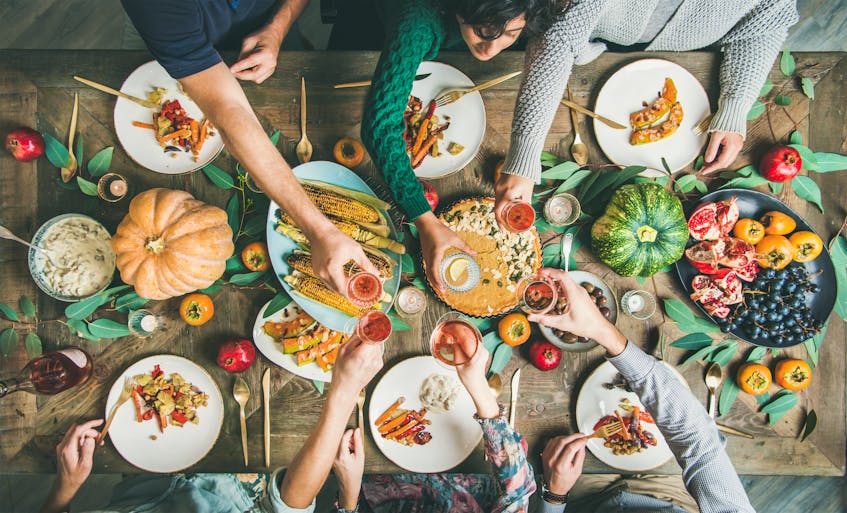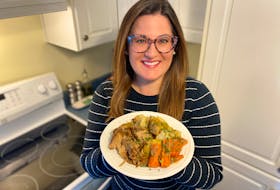When Sara Hawkins goes to holiday events that involve food, most often she’s bringing her own meal.
The Mount Pearl, N.L. woman is gluten intolerant and has learned to cope with holiday invitations.
If she’s with family, they know what to do and how to cook safely for her. But if she's going to a friend’s house, Hawkins typically offers to bring her own food, saying the hosts are fine with it as it's less stressful for them. Sometimes, she says, hosts have called her in advance and asked specific questions about what she can eat.
“I used to feel left out when I was first diagnosed; however, I don't feel left out or hungry anymore because I can manage. If anything, it helps me not to overindulge,” says Hawkins.
Communication key
When it comes to serving food over the holidays to a group of people, many of whom may have dietary restrictions, Hawkins says it’s all about the communication.
“Ask your guests what they can eat. Don't be offended if they decline to eat your food or if they bring their own,” says Hawkins.
Lori Moore, a holistic nutrition consultant and culinary expert based in Kingsport, N.S., agrees. She says it can be challenging for a host to accommodate special dietary requirements and it shouldn’t be the sole responsibility of the host or family cook to do so.
Moore says a good host can ask if anyone has dietary restrictions, or the guest can share their restrictions in advance and offer to bring a dish to share.
Moore's family, for example, have accommodated her requirement and, for the past 20 years, prepared a small serving of stuffing that wasn’t cooked inside the turkey. She brings along her own pre-cooked tofu for Christmas dinner.
If you have dietary restrictions and you’re not sure that the host will be accommodating, Moore says to plan ahead and eat something in advance so you’re not hungry from lack of options. Then, she says, focus on connection and interaction with family and friends rather than the food.
Make it easy

Terri Tremblett is the owner of Crumbles with a Twist Bakery based in Charlottetown, P.E.I., which also takes orders for gluten-friendly baked goods for delivery. She says there are a few easy ways to label food, making it easier for guests to differentiate.
Colour code dishes so that the gluten-free treats are on a different coloured plate, for example. Or, if a dish has several ingredients that may not be visually identified, include a small sign that identifies what it contains like “gluten-friendly” or “contains dairy.”
Use place cards, tent cards, or table marker stands to make it easy for guests. Tremblett says she has also used gift tags attached to the handle of a serving tray to identify ingredients.
Food experts from around Atlantic Canada have offered their suggestions on how to make holiday food more inclusive and healthier for everyone.
Gluten-Free
For a big meal that is serve yourself-style, consider cross-contamination for any gluten-free guests, says Hayley Ewing, the in-store dietitian with Atlantic Superstore in Bridgewater and Liverpool, N.S.
Place gluten-containing items at the very end or on a separate table from gluten-free items with their own utensils, as opposed to passing them around, risking crumbs from rolls getting on the wrong person’s plate. She also suggests the guest with food restrictions go first so they can plate their food before it has been touched by others.
Most side dishes are naturally gluten-free, like veggies, mashed potatoes, turkey, ham, and cranberry sauce, says Ewing. The stuffing is the riskiest item. Making it with gluten-free bread or substituting it for just potato and rice would make this gluten-free.
When it comes to desserts, Ewing says to consider a gluten-free pie crust for your guests. Pre-made products available now in the Superstore make this so easy you don’t have to mess with special ingredients.
Vegan
Most side dishes are already vegan, says Ewing. Think of anything with milk, butter, or eggs added - could these ingredients be swapped?
Take out servings for those guests with dietary needs to enjoy the dish before adding those ingredients for others, suggests Ewing. Products like plant-based butter and beverages make it easy to swap standard dairy ingredients.
Keto
Most side dishes, like veggies, are naturally low in carbohydrates, says Ewing. Consider sneaky sources of carbohydrates, like brown sugar, and provide these add-ins on the side.
Cauliflower is a popular mashed alternative to potatoes. Try roasting cauliflower in the oven to add some caramelized flavour before adding the milk and butter to mash.
Diabetics
Festive meals often feature food in abundance that is high in sugar, fat, and salt. Carbohydrate-containing foods - those with sugar, like sweets, and starch, like pasta, bread, and potatoes - elevate the blood sugar. In people without diabetes, the body can properly regulate blood sugar levels. But for those living with diabetes, blood sugar is far tougher to keep within a healthy target range, says Ann Besner, nutritionist and manager of research and public policy at Diabetes Canada.
To help prevent major blood sugar fluctuations, a person with diabetes should aim to eat in a balanced manner. So, including a variety of options at the holiday table - like vegetables, fruit, whole grains, and protein foods - is a great option, says Besner.
"Part of making a meal inclusive for family or friends with diabetes involves treating them with respect and not shaming their food choices. Very few people appreciate having their diets scrutinized or criticized," she says.
"Many people with diabetes are very aware of the impact food has on their disease management and what they need is support to eat well, not judgment."
Regular sugar in recipes can often be replaced in part or completely with a sugar substitute, like artificial sweeteners such as aspartame, sucralose or stevia-based sweetener, which doesn’t raise blood sugar. Besner says there are many recipes on the Diabetes Canada website that offer suggestions.
"One big, higher calorie meal isn’t making a difference in the grand scheme of things.
It's how you feel about what you’ve eaten that makes a difference."
Healthier substitutes
To make holiday food healthier for everyone, Moore suggests the following:
Serve a large variety of vegetables
Include raw vegetables and hummus; fresh fruit; raw nuts and seeds and olives as appetizers.
Add herb and spice combinations instead of heavy, creamy sauces to side dishes
In many sweets recipes, the butter and oil can be replaced with applesauce or mashed banana. Sugar can be reduced by at least one-third and up to half without compromising taste. Warm holiday spices like cinnamon, nutmeg, and allspice add sweetness to recipes as well.
Bake with coconut oil or ghee instead of butter or vegetable shortening
Also key, Tremblett says, is reducing salt in recipes and cutting fat by using lower fat or non-dairy milk. If nut allergies are not a concern, cream cheese can be made with cashews (search for “cashew cream cheese”).
There is no substitute for real butter in Christmas baking, though, she says.
There is a lot of research that shows eating too many foods that are high in sugar, fat, and salt can increase the risk of developing several different chronic illnesses, including heart disease, obesity and Type 2 diabetes. Eating a variety of healthy items and limiting the intake of highly-processed foods and drinks helps improve overall health and decreases disease risk, says Besner.
Indulge — a little
Unless it's for dietary concerns, Ewing encourages her clients to just enjoy the holiday food and not feel shame or guilt around eating more than they usually would.
"It’s a special occasion and part of our culture and traditions to celebrate with food," she says. "One big, higher calorie meal isn’t making a difference in the grand scheme of things. It's how you feel about what you’ve eaten that makes a difference."
Instead, eat regular meals throughout the day leading up to the big holiday meal. Skipping meals to make room for a big dinner can lead to extreme hunger, uncontrolled eating, and loss of focus on the event, says Ewing, making it more likely you'll eat until you're uncomfortably full.









